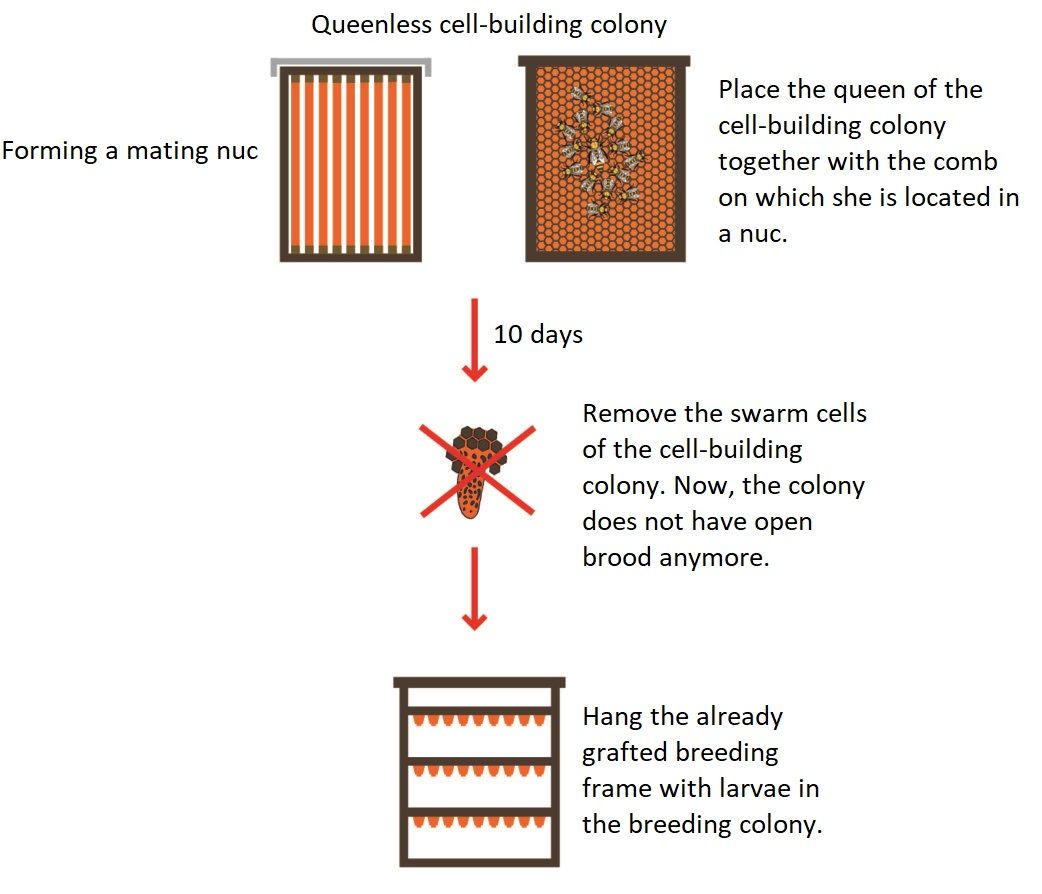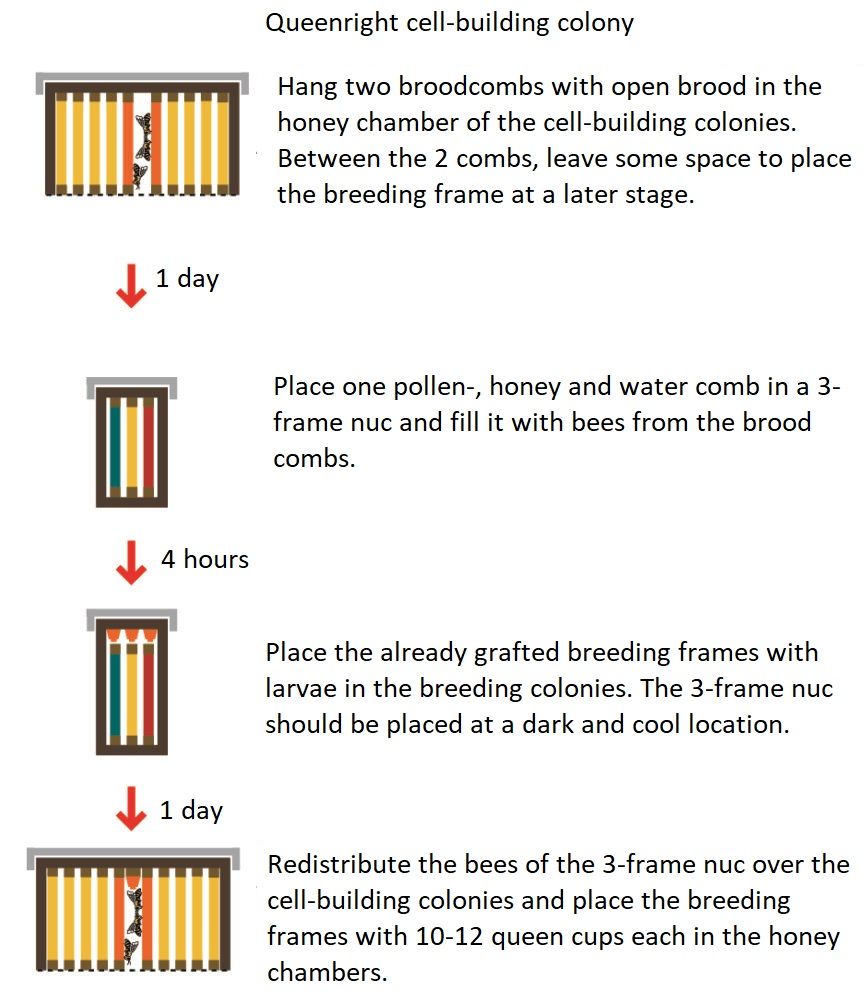The bees will be swarming again soon, which makes it a good time to start rearing queens. We give an overview of the basics and most common breeding methods, for everyone who like to crown their own queens.
Biological basics of queen rearing
As with all domesticated animals and crops, the breeding of honeybees has a long tradition and significantly influenced their characteristics. Honey yields have risen continuously over the last hundred years. This may be due to better beekeeping practice but is also the result of breeding of more productive honeybee colonies. Selective breeding utilizes the natural reproduction instinct of bees and stimulates colonies with desired characteristics.
Reproductive and repressive instincts
The queen is the mother of all worker bees and is the only female in the colony who can lay fertilized eggs. She is therefore indispensable for the survival of the colony. Young queens are reared by feeding the larvae «royal jelly» instead of pollen. However, a healthy queen will suppress the rearing of new queens, by releasing her so-called queen pheromone. This substance is continuously released by queens and distributed throughout the hive. If there is not enough space in the hive, the substance can no longer be spread properly. The bees which cannot sense the queen substance will therefore get in swarming mood. Further, older queens which can only spread small quantities of the queen pheromone, or a sudden loss of the queen, will trigger the bees to construct swarm cells. This behavior is used in queen breeding to induce the workers to raise new queens.
Artificial selection
In nature, only organisms that are able to survive and reproduce can pass on their genes to the next generation. This process of natural selection is the driving force behind the evolution of living beings. Through purposeful intervention in the biology of honeybees, natural selection can also be influenced. For example, disease treatments allow colonies to survive, regardless of their resistance or how strong or weak they are. By intervening in reproduction and deliberately promoting desired characteristics, so-called artificial selection or breeding is conducted.
The characteristics of a living being are determined both by its genetics and by its environment. So, the honey yield of a bee colony is influenced on the one hand by the local area and on the other hand by the foraging capability of the colony. Only hereditary characteristics can be specifically promoted in breeding and enhanced from generation to generation. In beekeeping, breeders aim to support characteristics which, increase the honey yield, promoting bee health and simplifying the beekeeping practice. Suitable characteristics for breeding are: spring development, colony strength, swarming instinct, cleaning instinct, winter fitness and gentleness.
Usually, the natural and artificial selections criteria match. It is in the interest of both beekeepers and bees to build-up large honey reserves and natural selection also favours strong, disease-resistant colonies. There are only two characteristics where beekeepers breed contrary to natural selection. While in nature aggressive bees have a better defense against enemies and therefore have better chances of survival, aggressive behaviour is against the interests of beekeepers. Also, a high tendency to swarm is advantageous for the bees as it is a natural reproduction process. Most breeders, on the other hand, try to minimize swarming as it leads to honey losses.
Breeding in cell-building colonies
Most breeding methods use a so-called cell-building colony and a breeder colony, The breeder colony is the colony with the queen with desired characteristics, which you want to reproduce. Eggs or young larvae (1 day old) will be taken out and placed in a cell-building colony. This cell-building colony will then rear the eggs and larvae. The cell-building colony should be strong and have sufficient food reserves. Therefore, future cell-building colonies can be strengthened with normal brood and feed to ensure the colony is strong throughout the queen rearing process. When breeding with a cell-building colony, a distinction is also made between queenless and queenright colonies.
Queenless cell-building colony
In order to get a queenless cell-building colony, one can either remove the queen from the colony (she can be used in a nuc) or you can form a «mating nuc». In both cases you must wait 10 days until the actual breeding process can be started. At the end of this waiting period, all queen cells (which the bees created themselves because there was no queen present) are removed from the cell-building colony and the eggs and larvae of the breeding colony are added. Between 15 and 40 young queens can be raised in a queenless colony.

Queenright cell building colony
During the breeding in a queenright cell-building colony, the bees are tricked into believing that there is no queen present. This induces them to rear new queens. The queen rearing process takes place in the honeycombs, where the adult queen is denied entry with a queen excluder. The honeycombs should be stacked with and the honey stores should therefore not be expanded shortly before breeding. There are two methods when rearing with in queenright, which in essence do not differ much from rearing in queenless cell-building colonies. Namely, with 3-frame nuc and starter-finisher. Both methods allow for the rearing of approximately 10-12 young queens.
3-frame nuc
With a 3-frame nuc, queen rearing can subsequently be carried out in four cell-building colonies. In order to prepare the cell-building colonies for breeding, two broodcombs with open brood are hung in the middle of the honey chamber, whereby some space is left between the two broodcombs. In this space, the breeding frame will be placed at a later moment. The nurse bees will now move from the broodcombs to the honey chamber to take care of the newly placed brood there. One day after the brood combs have been transferred to the honey chamber, the honeycombs, now stacked with nurse bees of three to four cell-building colonies can be united in one nuc. A pollen, a honey and a water comb (an empty in lukewarm water dipped comb) is added to the nuc. Since the nuc always remains closed, the box should be well ventilated. After a few hours of rest in a cool place, the breeding material (eggs and larvae) can be hung in the nuc. Then the bees in the nuc will need around 24 hours to care for the queen cells. After that the queen cups can be taken out and distributed among the cell-building colonies. The bees in the nuc can also be reunited with their original colony.

Starter
To obtain a starter, a box with four brood combs (flanked on both sides by one pollen- and one honeycomb) is placed on top of the hive of a strong colony. The already existing queen does not have access to this are by means of a queen excluder. The nurse bees of the colony will move up to take care of the new brood. After about one day, enough bees have moved upwards.
Now, a little trick is employed. Another colony, it should be a strong colony and there need to be good flying conditions (no rain for example) is moved next to the starter colony. During the course of the day, this colony will now receive the forager bees of the resettled colony. This results in a hive full of bees, the more bees the better as this is ideal when breeding new queens.
At the end of the day starter colony is complete and two to three frames with young eggs and larvae, together with one or two honeycombs can be added. At the same time, the cell-building colonies should also be prepared by transferring brood combs into the honey chamber (as described above). The queen cups can be removed after a maximum of 24 hours in the starter and distributed to the cell-building colonies or finishers. A starter colony can be used two times as maximum. Because such colonies is not for the long-term and the different bees in the starter should be re-united again with their original colonies.
Breeding within breeding colony
Instead of using a cell-building colony, swarm cells can also be taken directly from the breeding people. However, there is a general fear that this method fosters swarming behaviour. Nevertheless, even colonies with a low swarming tendency can be encouraged to build swarm cells by feeding them and keeping them in tight hive. The advantage of this method is that the nurse bees rear the larvae continuously from their development to queen. This results in stronger and larger queens compared to queens eggs or larvae that have been added to a cell-building colony.
Production of breeding material
Eggs and one-day larvae are suitable as breeding material and must be placed upside down in the cell-building colony. In order to get a large quantity of eggs and young larvae one has to hang an empty comb sprayed with sugar water in the middle of the breeding colony’s hive. From this comb, so-called egg-strips can then be cut out and attached to the breeding frame. Alternatively, one-day larvae (which lie on the brood combs directly next to the eggs) can also be turned into prepared queen cups. The best way is to use an grafting tool to pick up the larva from the back and place them in the queen cups. Make sure that the larvae are not turned over.
Mating boxes
In order to prevent swarming of the breeding colonies, swarm cells should be covered in time with protective cages or removed. If the queen hatches in the cage, she must be provided with some bee food fondant. The young queens or swarm cells can be added directly to a mating box. Depending on the size of the mating box, it should be filled with 500-3000 bees. Young bees of the respective cell-building colony are particularly suitable for this, as they accept and care for the young queen without any problems. When the box in filled with bees, the box should rest in a cool, dark place for two or three days, and sprayed regularly with water. Afterwards, the box can be set up for two weeks at the apiary or at a mating station
Adding queens
Successfully mated queens can finally be added to the targeted colonies. The highest acceptance is for new queens in brood-free colonies (but without drone-laying workers). Therefore you can wait 9 days after removing the old queen, after this time, remove the swarm cells and add the new queen. Alternatively, the targeted colony can be covered with newspapers and the whole mating box can be placed on top. The bees will then gradually eat their way through the paper. By the time the colony comes in contact with the queen, they are used to the smell of the new queen and will accept her.